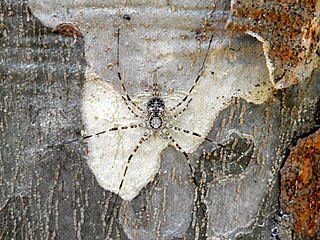
Ground spiders comprise Gnaphosidae, the seventh largest spider family with nearly 2,000 described species in over 100 genera distributed worldwide. There are 105 species known to central Europe, and common genera include Gnaphosa, Drassodes, Micaria, Cesonia, Zelotes and many others. They are closely related to Clubionidae. At present, no ground spiders are known to be seriously venomous to humans.

Ant spiders are members of the family Zodariidae. They are small to medium-sized eight-eyed spiders found in all tropical and subtropical regions of South America, Africa, Madagascar, Australia-New Guinea, New Zealand, Arabia and the Indian subcontinent. Most species are daytime hunters and live together with ants, mimicking their behavior and sometimes even their chemical traits. Although little is known about most zodariids, members of the genus Zodarion apparently feed only on ants; a number of other genera in the family are apparently also ant specialists.

Hersiliidae is a tropical and subtropical family of spiders first described by Tamerlan Thorell in 1870, which are commonly known as tree trunk spiders. They have two prominent spinnerets that are almost as long as their abdomen, earning them another nickname, the "two-tailed spiders". They range in size from 10 to 18 mm long. Rather than using a web that captures prey directly, they lay a light coating of threads over an area of tree bark and wait for an insect to stray onto the patch. When this happens, they encircle their spinnerets around their prey while casting silk on it. When the insect is immobilized, they can bite it through the shroud.

Prodidominae is a spider subfamily, sometimes called long-spinneret ground spiders. It was formerly regarded as a separate family, Prodidomidae, which was reduced to a subfamily of the Gnaphosidae in 2018.

Hersilia, also known as long-spinnered bark spiders and two-tailed spiders, is a genus of tree trunk spiders that was first described by Jean Victoire Audouin in 1826. Their nicknames are a reference to their greatly enlarged spinnerets.
Tama novaehollandiae or Tamopsis novaehollandiae are names used for an Australian spider species. However, the original type specimen has been lost, and it is not clear which, if any, of the many species of Tamopsis now recognized the name refers to, so it is treated as a nomen dubium. Tamopsis is placed in the family Hersiliidae.
Prethopalpus is a spider genus known as Goblin Spiders and are found in the Australasian tropics, including Nepal, India, Indonesia, Papua New Guinea and Australia. Three species are widely distributed, whereas the majority of species are recorded a single localities. Of the 41 species, 14 blind troglobite species live in subterranean ecosystems in Western Australia.

Desis is a genus of intertidal spiders that was first described by Charles Athanase Walckenaer in 1837. It is found in Australasia, the Pacific, Japan, eastern and southern Africa, and India. They are truly marine spiders, living in the intertidal zone and only emerging at night on the ebb tide to hunt for invertebrates and small fish. In the day and during high tides, they hide in an air chamber sealed with silk.

Tamopsis is a genus of tree trunk spiders that was first described by B. Baehr & M. Baehr in 1987. Like other members of the family, they may be called two-tailed spiders, referring to two elongated spinnerets. The name is derived from the genus Tama and the Ancient Greek ὄψις (-opsis), meaning "resembling".
Murricia crinifera, is a species of spider of the genus Murricia. It is endemic to Sri Lanka. The species was described with a female specimen collected from Kandy, Galle and Colombo.
Murricia is a genus of tree trunk spiders that was first described by Eugène Simon in 1882.

Neotama is a genus of tree trunk spiders that was first described by M. Baehr & B. Baehr in 1993.
Leichhardteus is a genus of Australian corinnid sac spiders first described by B. C. Baehr & Robert Raven in 2013.
Molycria is a genus of Australian ground spiders that was first described by Eugène Louis Simon in 1887.
Nomindra is a genus of Australian ground spiders that was first described by Norman I. Platnick & Barbara Baehr in 2006. Originally placed with the long-spinneret ground spiders, it was transferred to the ground spiders in 2018.
Prodidomus is a genus of ground spiders that was first described by Nicholas Marcellus Hentz in 1847.
Wesmaldra is a genus of Australian ground spiders that was first described by Norman I. Platnick & Barbara Baehr in 2006. Originally placed with the long-spinneret ground spiders, it was transferred to the ground spiders in 2018.
Wydundra is a genus of ground spiders that was first described by Norman I. Platnick & Barbara Baehr in 2006. Originally placed with the long-spinneret ground spiders, it was transferred to the ground spiders in 2018.
Barbara Baehr is a research scientist, entomologist, arachnologist, and spider taxonomist. She has described over 400 new spider species, mostly from Australia. She is originally from Pforzheim, Germany.







